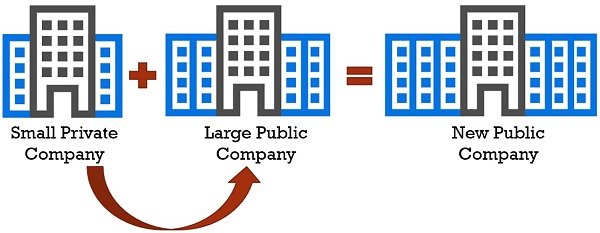Definition: Reverse Merger when a listed public company with no business is acquired by an unlisted private company with a viable business. Another term for the reverse merger is:
- Reverse Takeover (RTO)
- Reverse Initial Public Offering.
What is Merger?
A merger is when a large company subsumes a small company. Also, it involves the exchange of cash and shares. But, when a smaller firm takes the control of the larger enterprise, it is a reverse merger.
Concept of Reverse Merger
Reverse Merger is a strategic alternative for private firms to convert into public enterprises.
In other words, a reverse merger is a process in which a private company acquires a public company to get listed publicly. It also takes place when a profit-making company unites with a loss-making company. To become a public company, the private company purchases control of the public company.
Therefore, the shareholders of the private company get a substantial amount of ownership in the public company. Along with that, they also get control of its board of directors. Post-merger, the two companies merge and make a single company. The resultant company is a publicly-traded enterprise.
Also, the control of the newly formed enterprise lies in the hands of the management of the former private firm. And as you already know private firm is owned by insiders. Moreover, in a reverse merger, the company goes public without selling its shares. Thus, it does not go through the process of IPO.
Further, the acquired public company is a shell company. This means that it exists only on paper, and it has no assets. As well as it does not operate in reality. Through this, the private company can avoid the lengthy and intricate process of converting a private company into a public company. In this process, the parent organization merges into the subsidiary firm.
Points to Note
- A private operating company merges with a shell company.
- Issuance of a majority stake to the shareholder of the operating company in exchange for their shares in the operating company.
- After the merger, the shell company possesses the assets and liabilities of the operating company. But its control remains in the hands of the shareholders of the former operating company.
- The shell company is renamed with the name of the operating company. Also, the directors and officers of the operating company replace the directors and officers of the shell company.
- The shares of the newly formed enterprise continue to trade on the same stock exchange in which the trading of stock before its acquisition
Essentials of Reverse Merger
- The total value of assets of the larger firm must be more than the total value of assets of the smaller firm.
- Net Profit after tax and extraordinary items of the larger company must be more than the Net Profit after tax and extraordinary items of the smaller company.
- Issuance of equity share capital to the shareholders as consideration for acquiring the company must be more than the equity share capital of a small company before its acquisition.
- After the process of a reverse merger is complete, the small company undertakes the operations of the large company. And the large company will discontinue its existence.
- The reverse merger has to be in the public interest.
- The reverse merger will qualify in obtaining the tax benefits under Income Tax Act, 1961.
Process of Reverse Merger
The process starts when a healthy company and a shell company enter into an agreement. This agreement is Share Exchange Agreement.
This agreement contains all the terms of the agreement.
The shareholders of the operating company get a majority stake in the new company. Issuance of shares is in return for their shares in the operating company. Plus, the shareholders of the shell company obtain the remaining shares.
Post-merger, the shell company survives. And it comprises the assets and liabilities of the operating company. After the merger, the business which the healthy company carries out previously is undertaken by the shell company. Also, it gets a new identity.
To get the percentage ownership, a reverse stock split is to be conducted for the shell company.
A word from Business Jargons
A reverse merger is an uncommon type of merger. In this, the same group of shareholders controls the business of the operating company. Along with that the same directors and officials manage the company. But the only difference is that the operating company gets the public status of the shell company.
Further, in comparison to IPO’s, reverse takeovers are economical as regards processing time and regulatory requirements.

Leave a Reply